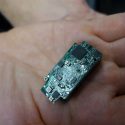UW-Madison invention basis for top honor in clean-energy competition
A new company built to commercialize a green-energy discovery at University of Wisconsin–Madison earned the top honor — and a check for $100,000 — at this month’s Chicago Clean Energy Challenge.
The firm, named Hyrax Energy, is developing a process to make sugar from cellulose, the tough carbohydrate that gives structure to plants.
That sugar could be a raw material for the biofuels, chemical and plastics industries. Ethanol, a biofuel added to gasoline, consumes about 40 percent of the total American corn crop. Using cellulose would reduce pressure on the price of corn and greatly expand the range of raw materials.
The new technology was developed by company co-founder Ron Raines, a professor of biochemistry and chemistry.
“We can take a cotton ball, which is essentially pure cellulose, and which does not dissociate in any common solvent, and drop it into this ionic liquid, and it dissolves. It’s like a magic trick,” he says.
The starting point came in 2002, when another lab discovered that certain liquids could dissolve cellulose. That opened the door to simpler processing, says Raines. “It’s much easier to do chemistry in a solution rather than on a solid.”
His 2009 process produced a type of molecule called a furan, but then Raines figured out how to arrest the reaction to produce glucose, a sugar that is a basic building block of chemical engineering. The process occurs in a single reaction vessel, at relatively low pressure and temperature.
The key step was adding an exact amount of water to halt the reaction when the solution was essentially a soup of glucose molecules. Water locks onto the glucose molecules so they cannot reassemble into longer molecules that would difficult to process, but too much water interferes with the reaction.
“We published this in 2010, and the same day, it was described in The New York Times as a potential game-changing way to make sugars from cellulosic biomass, non-edible biomass,” Raines says.
Although only small quantities of glucose have been made to date with the new process, it is extremely efficient, Raines says. “Over 90 percent of the mass of cellulose and related molecules in corn stover [waste material left after kernels are removed] are converted into sugar molecules. We have tested, and they support the growth of microorganisms that ferment sugar into biofuel.”
The research was funded by the Department of Energy through the Great Lakes Bioenergy Research Center on the Madison campus.
“We are thrilled to see that there is commercial interest in further developing the ionic liquids technology that was created in Great Lakes Bioenergy,” says director Tim Donohue, a UW–Madison professor of bacteriology. “The recent clean-tech award to Hyrax is outside endorsement of this promising technology.”
Converting cellulose rather than corn into chemical feedstock is a holy grail in the effort to convert more plant material into biofuels and other industrial chemicals.
Unlike many scientists, who are investigating biological methods to break apart cellulose, Raines focused on chemistry. “The enzymes that break down cellulose contain thousands of atoms, but a simple proton is enough to catalyze the reaction,” he says. “These protons can be sourced in acids, which are cheap and easy to come by.”
So far, the process has worked with corn stover, and other cheap or free sources of cellulose such as pine sawdust, wood and oat hulls, Raines says.
Hyrax Energy is at such an early stage of startup that it does not yet even have an office. The firm is negotiating to license the patent-pending Raines technology, which has been assigned to the Wisconsin Alumni Research Foundation.
Raines suggests the firm could move quickly once the license is signed. “Chemical processes have a tendency to be much faster to scale up, because they are simple and we are really good at building chemical plants.”
The Raines work is further evidence of the broad and deep expertise in plant-material conversion and green energy at the UW–Madison. The Great Lakes Bioenergy Research Center has a wide portfolio of techniques for converting plant material into chemical feedstocks. WARF has a library of patents from university research available for corporate licensing.
A Madison spin-off called Virent uses catalysts to make biofuel has more than 100 employees, and Raines says co-founder Jim Dumesic, a UW–Madison professor of chemical and biological engineering, was an “inspiration” in showing the potential of new methods for converting organic materials into industrial chemicals.
Subscribe to Wisconsin Ideas
Want more stories of the Wisconsin Idea in action? Sign-up for our monthly e-newsletter highlighting how Badgers are taking their education and research beyond the boundaries of the classroom to improve lives.
Tags: Bioenergy, business, research, spinoffs, The Wisconsin Idea



